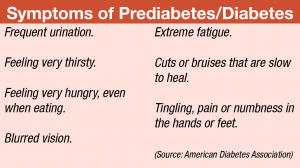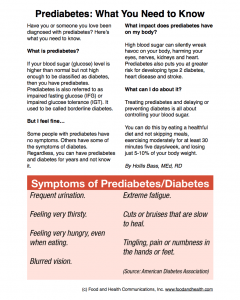Guide to Prediabetes
In honor of American Diabetes Month, we're cracking the vault to offer you the latest resources for your clients. Today's sneak preview is from Hollis Bass, MEd, RD, and it's all about prediabetes. To access the full article or join Communicating Food for Health so that you never miss an amazing resource again, drop by the Communicating Food for Health blog. Have you or someone you love been diagnosed with prediabetes? Here’s what you need to know.What is prediabetes? If your blood sugar (glucose) level is higher than normal but not high enough to be classified as diabetes, then you have prediabetes. Prediabetes is also referred to as impaired fasting glucose (IFG) or impaired glucose tolerance (IGT). It used to be called borderline diabetes.But I feel fine… Some people with prediabetes have no symptoms. Others have some of the symptoms of diabetes. Regardless, you can have prediabetes and diabetes for years and not know it.What impact does prediabetes have on my body? High blood sugar can silently wreak havoc on your body, harming your eyes, nerves, kidneys and heart. Prediabetes also puts you at greater risk for developing type 2 diabetes, heart disease and stroke.What can I do about it? Treating prediabetes and delaying or preventing diabetes is all about controlling your blood sugar. You can do this by eating a healthful diet and not skipping meals, exercising moderately for at least 30 minutes five days/week, and losing just 5-10% of your body weight.And here's a free handout for you to give to your clients!
Have you or someone you love been diagnosed with prediabetes? Here’s what you need to know.What is prediabetes? If your blood sugar (glucose) level is higher than normal but not high enough to be classified as diabetes, then you have prediabetes. Prediabetes is also referred to as impaired fasting glucose (IFG) or impaired glucose tolerance (IGT). It used to be called borderline diabetes.But I feel fine… Some people with prediabetes have no symptoms. Others have some of the symptoms of diabetes. Regardless, you can have prediabetes and diabetes for years and not know it.What impact does prediabetes have on my body? High blood sugar can silently wreak havoc on your body, harming your eyes, nerves, kidneys and heart. Prediabetes also puts you at greater risk for developing type 2 diabetes, heart disease and stroke.What can I do about it? Treating prediabetes and delaying or preventing diabetes is all about controlling your blood sugar. You can do this by eating a healthful diet and not skipping meals, exercising moderately for at least 30 minutes five days/week, and losing just 5-10% of your body weight.And here's a free handout for you to give to your clients! There are tons of other diabetes education materials in the Nutrition Education Store!
There are tons of other diabetes education materials in the Nutrition Education Store!

 Remember, this post is only an excerpt of Hollis Bass's guide to prediabetes. For details about diabetes risk, medication options, family testing, diabetes risk factors, and more, get a Communicating Food for Health Membership today! Or get the details of the membership by clicking the image below...
Remember, this post is only an excerpt of Hollis Bass's guide to prediabetes. For details about diabetes risk, medication options, family testing, diabetes risk factors, and more, get a Communicating Food for Health Membership today! Or get the details of the membership by clicking the image below...
